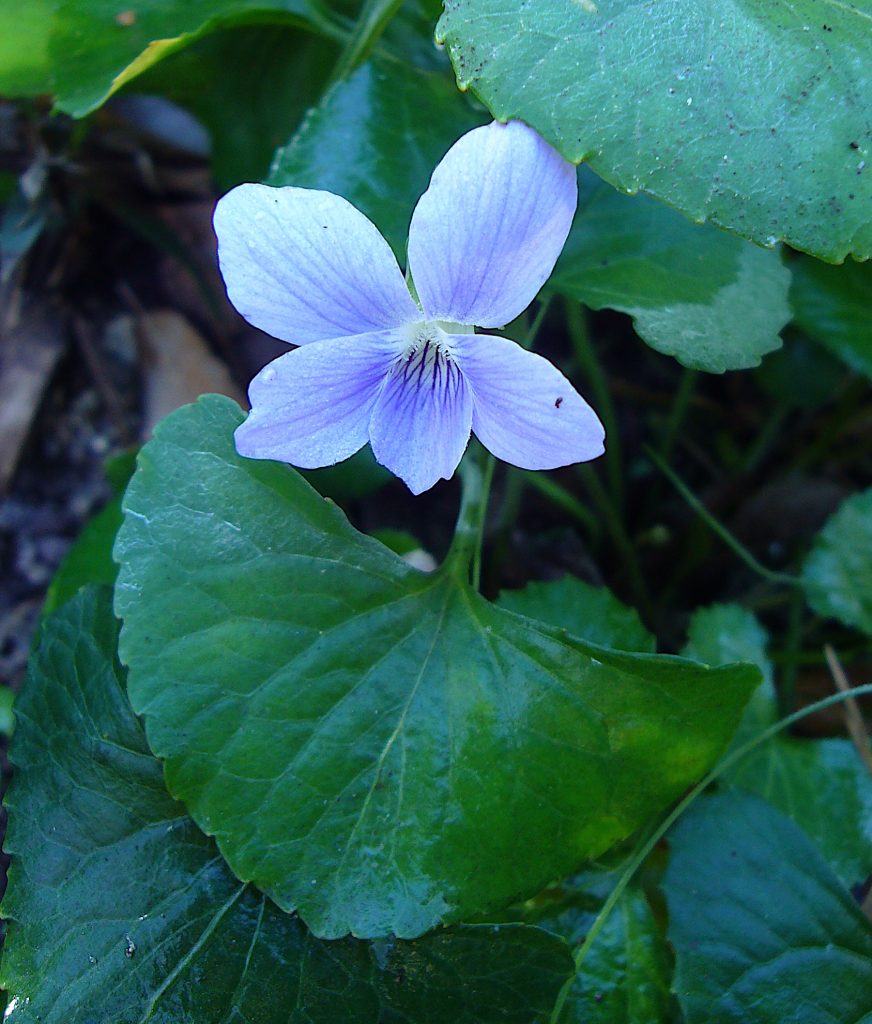
All Violets in the genus Viola are edible. Photo by Green Deane
A wild edible that’s easy to identify is the wild violet. We ate some this past week in my foraging class. It’s cultivated brethren is the pansy. There are a huge variety of violets in North America ranging from Field Pansies to those that like to grow down hill from the septic tank, Johnny Jump-ups. Whether wild or cultivated violets are attractive, personable blossoms, usually on the sweet, viscous side. There are a few precautions, however. The first is to make sure the soil they are in — either a pot or bed — is wholesome and that the water they are getting is good. If they come from a garden center they might have pesticides on them. And do not eat the root, it is toxic. Another precaution is a bit more esoteric: Yellow blossoms tend to have a laxative effect. Also make sure your “violet” is in the genus viola. Several plants called “violet” are not true violets and not edible.You can read about violets here. I have a video about them here.
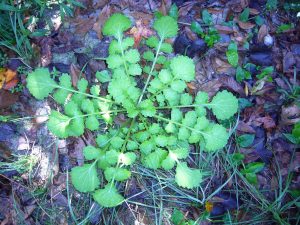
Toxic young Butterweed can make one think of mustards. Photo By Green Deane
It’s time for a warning about Butterweed. We found several examples of this toxic plant during our foraging class last Sunday. I learned it as Senecio glabellus but now some are calling it Packera glabella. This plant can put you in the hospital with serious liver damage within hours. It is not on par with some toxic mushroom but it’s down the same sickening road. There was a case in Southwest Florida just a few years ago. From a forager’s point of view Butterweed can — from a distance — resemble wild mustard or wild radish and like those species favors cooler weather.
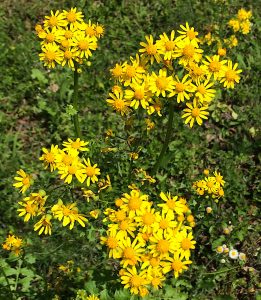
Butterweed’s blossom does not resemble a mustard. Photo by Green Deane
On closer inspection it clearly is not a mustard. The blossoms are like yellow daisies, not a four-petaled cross or H like mustards, and the leaves are not sandpappery but smooth nor does it taste peppery or mustardly. Growing in wet spots, Butterweed delivers its load of alkaloid pyrrolizidines without warning. Most alkaloids are bitter. Butterweed leaves are deceptively very mild in flavor and have a pleasing texture. Mustards do not. They are usually scruffy. Butterweed is in the Aster family which is 1) huge with some 23,000 members, and 2) plants in that family usually are not toxic. It is one of the exceptions and when it is very young it can also resemble edible Hairy Bitter Cress and likes the same environment. However, Butterweed does not have any noticeable flavor, Bittercress does as do the other mustards. You can read more about pyrrolizidines here.
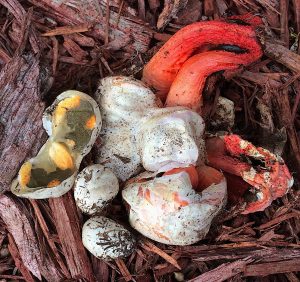
Stinkhorn Mushroom. Photo by Green Deane
Populating my mushroom pages now are stinkhorns, the most of them being a gazebo-shaped one called Clathrus columnatus. The other is Phallus ravenelii … you can guess what that looks like. They both smell like a dead body. When young — the egg stage — they smell quite tasty but when past the juvenile stage smell like carrion (to attract the carrion fly to spread its spores around.) Opinions vary whether Clathrus columnatus is edible in the “egg” stage. I don’t conveniently see them that often in the “egg” stage to give them a try. Phallus ravenelii is definitely edible in the egg stage and has a flavor similar to radish. If you are near mulch and you smell dead flesh it is probably a stinkhorn not a carcass.
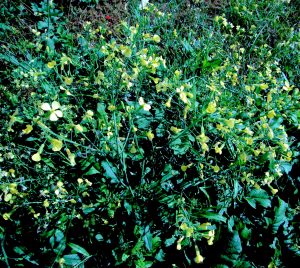
Wild Mustard and Wild Radish look very similar. Photo by Green Deane
Weed Seeds: You can plant many weed seeds to get a crop of edible weeds closer to home, if not in your own yard (now you know why my putting-green neighbors loathe me.) Weeds are designed to take care of themselves and do quite well even when ignored. I have planted wild radish, peppergrass, chickeweed, Bidens alba, purslane and crowsfoot grass on my “lawn” and they have done quite well. Many weeds can be planted in your garden. Chinopodiums and amaranth are two that need very little encouraging. Plant them a row, barely cover the seeds with soil and you will have a mess o’ greens. Mustards are a bit pickier to grow. Their seeds, such as peppergrass, should be stored in a dry area for about four months between 50 and 68 degrees Fahrenheit for optimum germination. A cellar stairs is just about perfect for that, or outdoors in a Florida winter. Other seeds need special treatment.
Pokeweed seeds are a good example. Their germination rate is very low, around 6 percent, if not treated. What’s treated? Replicating a bird’s gut. Soaking the seeds in battery acid for five minutes increases the germination rate into the 90s. You can buy the battery acid at auto stores. One container will last you decades. Once treated, plant successive rows of pokeweed seeds and have a lot of pokeweed from your garden. You can harvest the shoots or let them turn into big roots that will send up shoots annually.
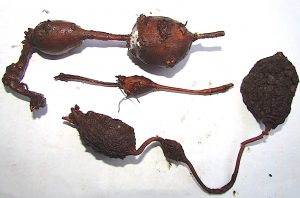
No other root has the growth pattern of the Groundnut east of the Rockies. Photo by Green Deane
If you’re more inclined to grow roots consider the groundnut. Just take tuber home, put it in the garden and wait, two years unfortunately but they will produce and produce well. Twenty years ago agriculturists at the University of Louisiana were trying hard to make the groundnut a commercial crop. Unfortunately when the professor in charge of the program retired so did much of that program. You can, however, find cultivars of the species for sale on the internet. Groundnuts can also be grown from seeds, but the process is more involved. Video here.
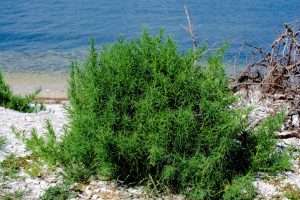
Seablite growing near the beach. Photo by Green Deane
My latest planted weed is Seablite, Suaeda linearis, which should be a commercial crop. When I’m asked what wild plant should be cultivated Seablite is always the answer. It has a nice flavor and texture, is bug and disease resistant, has a high germination rate, and is salt tolerant meaning it can be watered with brackish water (a good crop for all those unusable salt marshes.) It is also a seasonal crop and related to Amaranth.
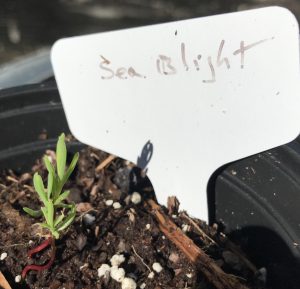
Seablite Seedling. Photo by Green Deane
While it has sprouted in my pots it will be a couple of months before one can easily find it in the wild. A 100-gram sample of a close relative, S. maritima was 83% water, 6.21% fiber (4.78 insoluble, 1.43 soluble) 3.46% protein, 2.18% carbohydrates, and 0.15% fat. The vitamin C amount was small,15.69 mcg but its 3.54 mg of beta-carotene meets half your daily need. Most amazing, however, was Seablite’s calcium content. It was a huge, 2471 mg, almost two and a half times your daily need.
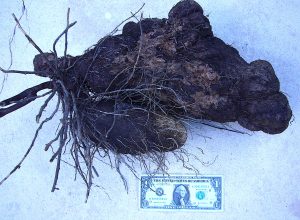
It’s common to find ten-pound D. alata roots. Photo by Green Deane
Finding edible plants this time of year brought the Winged Yam and the Omicron variation of COVID to mind. In my foraging class last Sunday — in the rain — we dug up five edible Winged Yam roots, Dioscorea alata. Cook them like a potato then eat. They taste like a potato and have a similar nutritional profile but to the pallet they are a little more silky in texture than a potato which can be granular. They are not impossible to find this time of year but they are dying back making them hard to locate. More to the point they die back from the ground up so while one can still find the green vine up the tree where it went into the ground to dig up the root is more elusive. What connection does this have to COVID? They are predicting an Omicon Blizzard in the next three to four weeks with so many people ill goods and services might be interrupted including food. Locally that means Hurricane Mode or where I grew up, Blizzard Mode. It’s unfortunate that this is almost the most difficult time of year to find the Winged Yam (It will be worse in a month, at least now one can find the general location where they are growing from the still-green vines. Finding some now and marking where the roots are could make things easier in the future.) You cal also plant the alata air potatoes for a future crop.

Classes are held rain or shine (but not during hurricanes.)
Foraging Classes: It might be chilly for classes this weekend but we will still go foraging. Saturday is in Gainesville, Sunday Melbourne.
Saturday January 22nd, Boulware Springs Park, 3420 SE 15th St., Gainesville, FL 32641. Meet at the picnic tables next to the pump house. 9 a.m. to noon.
Sunday January 23rd, Wickham Park: 2500 Parkway Drive, Melbourne, FL 32935-2335. Meet at the “dog park.” 9 a.m. to noon.
Saturday January 29th, Bayshore Live Oak Park, Bayshore Drive. Port Charlotte, meet at the parking lot at Bayshore and Ganyard, 9 a.m. to noon.
Sunday January 30th, Red Bug Slough Preserve, 5200 Beneva Road, Sarasota, FL, 34233. 9 a.m. to noon. Meet at the playground.
Sunday February 6th, John Chestnut County Park: 2200 East Lake Road, Palm Harbor, FL 34685. Meet at the trail head of the Peggy Park Nature Walk, pavilion 1 parking lot. 9 a.m. to noon.
For more information, to pre-pay or sign up go here.

Green Deane videos are now available on a USB.
My nine-DVD set of 135 videos has been phased out and replaced by a 171-video USB. The USB videos are the same videos I have on You Tube. Some people like to have their own copy. The USB videos have to be copied to your computer to play. If you want to order the USB go to the DVD/USB order button on the top right of this page or click here. That will take you to an order form. Or you can make a $99 donation, which tells me it is for the USB (include a snail-mail address.) I’d like to thank all of you who ordered the DVD set over the years which required me to burn over 5,000 DVDs individually. I had to stop making them as few programs now will read the ISO files to copy them.

Green Deane Forum
Want to identify a plant? Perhaps you’re looking for a foraging reference? You might have a UFO, an Unidentified Flowering Object, you want identified. On the Green Deane Forum we — including Green Deane and others from around the world — chat about foraging all year. And it’s not just about warm-weather plants or just North American flora. Many nations share common weeds so there’s a lot to talk about, such as the one to the left. There’s also more than weeds. The reference section has information for foraging around the world. There are also articles on food preservation, and forgotten skills from making bows to fermenting food. Recent topics include: California Wild Mushroom Parties, A Good Reason To Eat Wild Garlic, Black Walnuts and Amaranth, Sea Salt and Plastic, Wild Mustard? Heavy Metals. Oriental Persimmons. What is it? Pine Cough Drops and Needles, Skullcap, Malodorous Plant? Another NJ Tree, Maypop? Roadside Plant, Unknown in Sudan, Please Help Identify, and Preserving Prickly Pear Bounty. You can join the forum by clicking on the button on the upper right hand side of this page.
This is my weekly newsletter #491. If you want to subscribe to this free newsletter you can find the sign-up form in the menu at the top of the page. My website, which is data secure, has over 1500 plants on it in some 428 articles. I wrote every one myself, no cut and paste.
To donate to the Green Deane Newsletter click here.

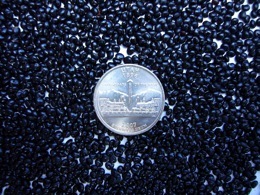

Thanks for the info on Buttercress! could you possibly show the side by side differences between the Buttercress and the wild edible cress and wild radish. I’m having difficulty finding what to look for to determine the difference ,and don’t want to make a deadly mistake. I really enjoy your weekly newsletters. I’m currently foraging my property on the Eastern Shore of Virginia
Thanks
You are confusing common names. One is Butterweed, the other is Bitter Cress. When very young they look similar but when crushed one smells mustardy.